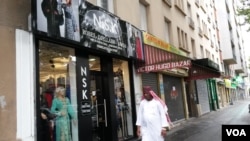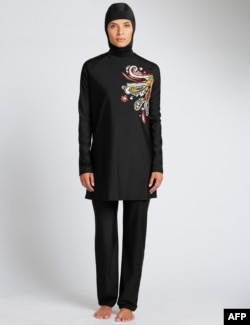Since Neslihan Cevik launched M-Line Fashion last December, her on-line company has been growing 20 percent monthly, fed by word of mouth alone. Today, the Turkish founder is looking beyond her stylish tunics and veils, hoping to launch a line of Muslim swimwear by next summer.
“It’s so ugly right now,” says Cevik of the head-to-toe covering suits, commonly branded as burkinis. “That’s one of the biggest problems for Muslim women. Whatever you do, all the designs we’ve had so far have been so ugly.”
Many French politicians see another message in the burkini, a semantic fusion of the burka and the bikini that was first launched in 2007 by Australian designer Aheda Zanetti.
This month, a growing number of towns and cities have banned the Muslim swimsuit from their beaches, citing a raft of reasons, from public order and hygiene, to water safety and respecting France’s fiercely secular principles. Last week, the Riviera city of Nice joined the expanding list, citing among other arguments, the Bastille Day terrorist attacks that killed 86 people.
Summer of sizzling controversy
No matter that the burkini is a rarity in France, and its very definition is vague. In a country that has banned the face covering veil, or niqab, along with the veil in public schools, the Islamic swimwear has sparked a sizzling summer controversy — and laid bare battling visions of the role of Muslim fashion in shaping female identity.
Prime Minister Manuel Valls described the burkini, along with the veil, as a form of enslavement — a view shared by Women’s Minister Laurence Rossignol.
“The burkini is not a new swimsuit model, it is not a trend,” Valls told La Provence newspaper, lending support to the town bans. “It is a political project that goes against modern society.”
Far from oppressive, designers like Cevik argue, the bathing suit and other modern Muslim wear can be liberating. The barriers are instead posed by a fashion industry that is often light years behind the needs of conservative modern women — and which is losing out on a potential gold mine in the process.
“Hijabi women are engaged in different aspects, spheres and activities of modern life — but the market hasn’t taken them seriously so far,” says Cevik, a sociologist who has authored a book on the post-‘80s transformation of the Muslim identity.
“The clothing for that woman has been like, ‘she’s oppressed, she stays at home or goes to her in-laws,’" Cevik adds. “It’s only now that markets are catching up with that new image.”
More designers jumping on board
Today, a growing number of designers are beginning the fill the void, offering trendy and colorful choices to a new generation of fashion-conscious ‘hijabistas.’ Even mainstream department stores and brands are beginning to catch on to the boom, eyeing a Muslim market expected to be worth several hundred billion dollars in the next few years.
Britain’s Marks & Spencer and House of Fraser debuted burkini swimsuits in Europe this year. Other departments stores like Mango and DKNY have launched “Ramadan” fashion collections themed to the holy Muslim month of fasting. Yet critics say the offer is limited — somewhat like the options offered to plus-sized women.
“You’re going to find one little section for the hijabi woman,” Cevik said. “Rather than integrating, I find it to be kind of segregating.”
Cevik’s M-Line brand targets young, college-aged women who frequent cafes, listen to Latin music and opt for "Muslim hipster fashion” — backpacks twinned with headscarves, jeans or pleated skirts.
“They don’t want to wear the typical long overcoats,” she says. “They’ll do anything any young female would do. What’s different is they’re passionately religious.”
Worldwide interest in designs
While most of M-Line’s clientele is Turkish, the brand is attracting sales from France and other European countries, even as far away as South Africa. Cevik’s next goal is to open a London showroom to broaden its reach.
She’s not the only designer shaping fashion choices. Fifteen years ago, Cindy van den Bremen helped to launch the Capsters brand of Muslim sports headgear, inspired by a Dutch ban on wearing hijabs to gym class over safety concerns.
“I realized it was not about the covering itself, but the way the girls are covered,” she recalls. “As a designer, I could solve that.”
Van den Bremen has since created a football friendly hijab that helped convince football’s governing body FIFA to lift its hijab ban. A Saudi fencer also wore one of her designs at the Rio Olympics.
“There are so many millions of Muslims living worldwide, especially in the diaspora. The second and third generation can now afford to wear clothes they want to wear,” she says. “It’s kind of strange to ignore this Muslim market.”











